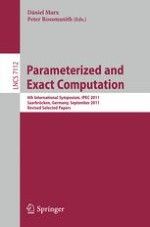This book constitutes the thoroughly refereed post-conference proceedings of the 6th International Symposium on Parameterized and Exact Computation, IPEC 2011, in Saarbrücken, Germany, in September 2011. The 21 revised full papers presented were carefully reviewed and selected from 40 submissions. The topics addressed cover research in all aspects of parameterized and exact computation and complexity, including but not limited to new techniques for the design and analysis of parameterized and exact algorithms, fixed-parameter tractability results, parameterized complexity theory, relationship between parameterized complexity and traditional complexity classifications, applications of parameterized and exact computation, and implementation issues of parameterized and exact algorithms.
